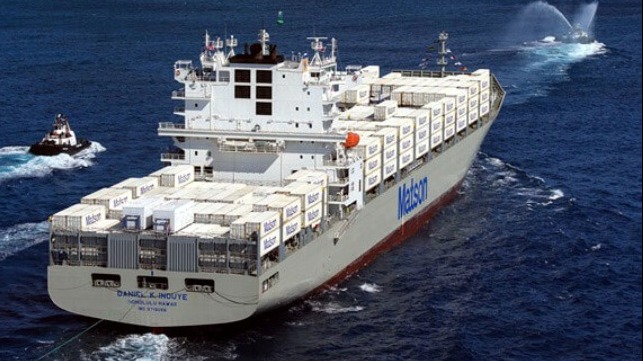Matson Proceeding with LNG Retrofit for 2018-Built Containership

Matson Navigation is moving forward with a plan to retrofit one of its large containerships for LNG-fueled operations making it one of the first shipping companies to pursue the conversion of their existing ships. MAN Energy Solutions reports that it has signed a contract for the retrofit of the main engine aboard the 2018-built Daniel K. Inouye along with an option for an unnamed second vessel, likely her sistership Kaimana Hila also built at Philly Shipyard and delivered in 2019.
When she was introduced in November 2018, the Daniel K. Inouye was the largest containership ever built in the United States. At over 51,400 dwt, the 850-foot long, vessel was also Matson's largest ship and its fastest, with a top speed in excess of 23 knots. She is rated with a capacity of 3,600 TEU and was outfitted with the MAN B&W 7S90ME-C engine designed to be adapted to use liquefied natural gas (LNG) in the future.
“Retrofitting a MAN B&W engine to dual-fuel running is a straightforward, proven process as our standard, electronic diesel engines are already built as ‘dual-fuel ready’ and are therefore readily convertible,” said Jens Seeberg, Head of Retrofit & Upgrades at MAN Energy Solutions, PrimeServ Denmark. “Dual-fuel retrofits offer a viable pathway to shipowners such as Matson who foster a company-wide ethic of environmental sustainability and wish to achieve a net-zero carbon footprint by 2050. Ultimately, when bio-LNG and SNG come online in sufficient volumes, ME-GI engines operating on these fuels will also satisfy such net-zero aspirations.”
During the retrofit, the engine will be converted to the MAN B&W 7S90ME-GI type capable of operating on LNG and fuel oil. According to MAN, the gas injection engine has set a new industrial standard for two-stroke propulsion engines. It is high-efficiency, two-stroke technology, without the greenhouse emissions such as methane slip that are characteristic of other engines. MAN Energy Solutions states that, as the lowest carbon-intensity fuel, operation on LNG is projected to reduce the Daniel K. Inouye’s CO2 emissions by 24 percent with a maximum, guaranteed, ultra-low methane slip of between 0.20-0.28 g/kWh across the load envelope.
As part of the retrofit solution, MAN Energy Solutions will also provide a high-pressure pump and vaporizer for MAN B&W ME-GI engines, which will be integrated into the Daniel K. Inouye’s Fuel Gas Supply System. The PVU pressurizes LNG to 300 bar and vaporizes the liquefied fuel to gaseous form for supply to the main engine.
Details were not announced on the timeline or location of the conversion. Post-retrofit, the Daniel K. Inouye is expected from mid-2023 to continue to operate on trans-Pacific routes between the U.S. West Coast and Asia.
Matson will be one of the first shipping companies to undertake the conversion of a large vessel to LNG while others such as BW LPG converted vessels to operate on LPG. Hapag-Lloyd completed the first conversion in 2021 on one of its South Korean-built containerships to operate on LNG. Despite also being designed for the LNG conversion, Hapag reported the cost was $35 million which made further conversions financially impractical. The German carrier viewed the conversion as a pilot project noting that the conversion cost would have to be brought down by a third to make sense to proceed with further conversions.
Matson built the Daniel K Inouye and her sister ship using the MAN engines that would permit the conversion to LNG. They also built two other containerships, the Lurline and Matsonia, calling them its first LNG-ready combination ro-ro containerships. The four ships were built as part of an extensive fleet modification effort replacing older diesel-fueled vessels that would not meet the newer environmental requirements.
